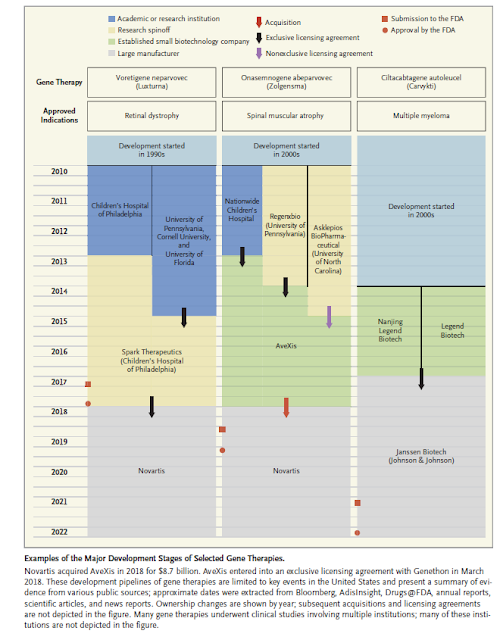Sources of Innovation in Gene Therapies — Approaches to Achieving Affordable Prices
Miro el NEJM i em trobo un article sobre com pagar la innovació farmacèutica que ve, tema molt important del que no s'en parla prou. I allà es recorda el seu origen:
All gene therapies approved in the United States thus far have their origins in academic institutions or spinoffs from such institutions that developed indispensable know-how and underlying forms of technology
I també recorda l'alt preu pagat per l'adquisició d'aquestes noves empreses amb l'expectativa de preus desorbitats.
Pharmaceutical manufacturers have actively participated in latest age clinical development and testing of the approved gene therapies, and a few have played major roles in expanding the market for these therapies, often by buying smaller companies. The costs associated with these acquisitions and licensing agreements can be very high. For example, Gilead was reported to have acquired Kite Pharma (which had rights to axicabtagene ciloleucel and brexucabtagene autoleucel) for $11.9 billion, and Novartis acquired AveXis (which had rights to onasemnogene abeparvovec) for $8.7 billion. The costs of such intellectual property are largely driven by the absence of limits on drug prices in the U.S. market. The resulting high prices can impose an enormous acute financial burden on patients and payers.
I després explica què fer. Una primera opció seria produir acadèmicament teràpies genètiques. L'exemple CAR-T ens sonarà familiar, i cita Suïssa però s'oblida l'Hospital Clínic i de l'Hospital de Sant Pau:
The cost to produce tisagenlecleucel, for example, was estimated at approximately $70,000 — a fraction of the therapy’s current prices in the United States and Europe. One approach would be for academic and other research institutions to conduct or contract out late-stage development activities — such as managing clinical trials, corresponding with and submitting applications to the FDA, and manufacturing — for publicly funded treatments that they discover. University hospitals in Switzerland have formed an alliance to manufacture gene therapies in-house to reduce costs and improve accessibility.
L'altra opció seria, llicenciar:
Regulators and policymakers could encourage institutions that receive federal funding to engage in nonexclusive licensing for certain key platform innovations that are part of the gene-therapy processes they have developed, in keeping with their mission and in recognition of the public funding that supports such discoveries. Licensing to multiple manufacturers would spur competition, which could help improve the technology over time and contain treatment prices.
I la tercera, compra conjunta
A third approach would be to facilitate systemwide price negotiation for gene therapies. In industrialized countries that have mechanisms for drug-price negotiation, prices for such therapies are high but still generally lower than prices in the United States
Més que opcions possiblement són desitjos. La darrera seria la mesura més definitiva de totes. Les multinacionals són globals, els mercats locals. Però tot i així ens enfrontaríem a gestionar amb transparència la discriminació de preus per part dels pagadors i reguladors. Implica un govern planetari inexistent, i si existís potser l'altra part no voldria negociar...
En definitiva, d'això s'en diu "wishful thinking", pensament il·lusori. D'il·lusió també en viu el NEJM.
Imatge per guardar i ensenyar quan calgui explicar d'on venen les innovacions...
PD. Fa uns cinc anys vaig fer una conferència on vaig explicar com la farmàcia hospitalària s'enfrontava a un canvi en la funció de producció. I aquest canvi seria provocat inicialment pel receptor antígen quimèric per a les cèl·lules T, CAR-T. Es van sorprendre força. Els temps passa i confirma el que vaig dir. El que sorprèn és que no s'hagi formalitzat com a tal aquest canvi i no es plantegi un canvi organitzatiu profund on s'analitzin les economies d'escala i aprenentatge possibles.

